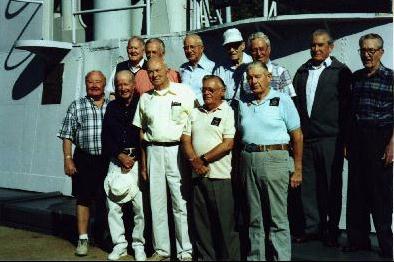Archer-fish crew recalls sinking largest ship in Japanese Navy
By Bob
Colby
Published on 9/22/2000
 |
The Japanese carrier Shinano was so close that if the American submarine Archer-fish (SS 311) hadn't fired its torpedoes, the carrier would have run over the sub.
Leo “Doc” Carter, a heavyset retired Navy chief hospital corpsman, was describing the encounter and subsequent sinking of the supercarrier on Nov. 29, 1944. “That sinking,” said Carter jubilantly, “was the Archer-fish's claim to fame.” At more than 69,000 tons, the newly built Shinano is believed to be the largest warship ever sunk and its demise earned the Archer-fish the Presidential Unit Citation and a Navy Cross for its skipper.
The carrier was only 1,400 yards from the Archer-fish when the sub's commanding officer, Joseph F. Enright, fired six torpedoes and scored at least four hits. The sub shadowed the vessel for eight more hours until the Shinano finally rolled over and sank.
Hailed by the Japanese as unsinkable, the carrier was only 10 days out of Tokyo Bay on its maiden voyage when it was spotted by the Portsmouth, N.H.-built fleet sub on its fifth war patrol.
Carter, a 76-year-old ruddy-faced retiree from Coca Beach, Fla., didn't join the Archer-fish until a year after the Shinano sinking. But his former shipmate, Carl “Wilkie” Wilken of Sandusky, Ohio, was a motor machinist's mate on duty in the forward engine room at the time.
Both chuckled as they recounted the serendipitous story of how the enemy vessel was encountered.
The day before the sinking the sub's radar had gone on the fritz and the boat remained submerged as the unit was being repaired. At dusk the job was completed and the skipper ordered the sub to surface so he could take a radar bearing on a nearby island. But the “island” appeared in the wrong direction and Capt. Enright called down to check the discrepancy with radar officer, Lt. Joseph Bosza.
“That island,” bellowed Lt. Bosza, “is moving at 20 knots!”
Yhey had spotted was the Shinano escorted by three destroyers. For six hours, Enright maneuvered Archer-fish on the surface at 20 knots before reaching a position in front of the carrier and unleashing the torpedoes.
The three destroyers dropped 14 depth charges during the attack but none exploded close by, says Wilken. When the carrier sank, he said, there was elation throughout the boat.
The U.S. Naval Historical Center has called the sinking of Shinano “the largest single victory of the submarine war.”
Sadly, “Capt. Joe” as he is reverently remembered by his former officers and crew, was not at this year's sub reunion earlier this month at the Radisson Hotel in New London. He died July 20 at home in Fairfax, Va., after suffering a stroke. In 1987, he co-authored the book “Shinano! The Sinking of Japan's Secret Supership.”
More than 40 Archer-fish war vets and their family members did attend this year's 19th annual get-together and as Wilken joked: “The war stories we tell are still changing.”
When Doc Carter was 21, he was the youngest chief petty officer in the submarine service and possibly in the Navy. After retiring from the Navy, founded a community mental health agency in Detroit. He retired in 1990.
Wilken, after completing his wartime service, joined his family's heating and air-conditioning business in Sandusky. Now 78 with wispy white hair, he retired in 1986. The company is now run by his son, Dave Wilken, who along with Carter's children, Fred Carter and Julie Carter-Simon, attended this year's reunion.
A couple of years ago, the sub vets decided to encourage their children to attend the get-togethers, as Wilken put it, “to see what we did in the Big One.”
Carter's wife, Mary Ann, and Wilken's wife, Mary Ellen, also attended.
This is the third time an Archer-fish reunion has been conducted in New London and many crewmen warmly recalled their wartime liberties here while they attended Submarine School at the sub base in Groton.
This year's five-day reunion was an informal one with no main speaker at Thursday night's banquet at the Radisson. Veterans toured the region, including visits to the U.S. Submarine Force Museum, the Submarine Base, Mystic Seaport and other attractions.
After wartime service, Archer-fish was decommissioned and recommissioned twice but as the Archerfish, without the hyphen.
During an underwater inspection in the late 1960s, a diver found that the boat, then designated as an oceanographic vessel, had lost its starboard stern plane and the sub was destined for a burial at sea.
It was towed to sea and sunk as a target by the submarine Snook in 1968.
The old diesel boat was succeeded by a nuclear boat of the same name, which is now decommissioned.
After the reunion, Carter will return to his computer to continue searching databases for other Archer-fish shipmates who have not been located. “Every year,” he lamented, “we lose more reunion members.”
Bob Colby's email address is
r.colby@newlondonday.com. ![]()